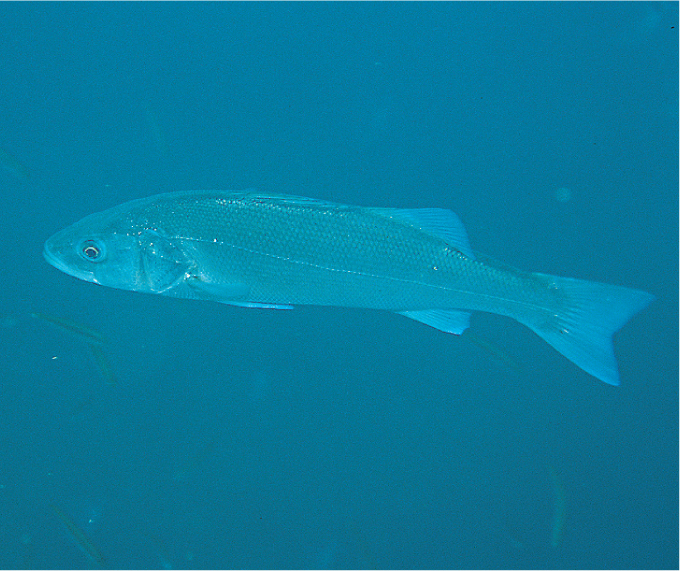
GROUPERS
Family Serranidae
The grouper family has few representatives in the region and has been hunted mercilessly for many years by fishermen. The flesh is highly prized and when you consider that some larger specimens can weigh several hundred kilos, you can understand the greed that is attached to the catch. Thankfully there are many established marine parks where the largest of the grouper are still abundant. They hunt by rushing at their victims with their mouths open, sucking in the prey. All fish start as females and change into males as they get older. This could upset the development of the species if the larger fish get caught.
SWALLOWTAIL SEAPERCH
Anthias anthias


This is a wonderfully coloured anthias from which all the other species descriptions are derived. It grows to around 10cm (4in) and is pink to red in colour with long pelvic fins, which are rounded and tinged with yellow. The tail is long and tapering and the adult male has an extended dorsal spine, which is bright yellow. It also has variable markings around the eyes and snout. Ecology: All fish in the small schools are females except for the largest one which is the male. Like many other species of fish, when the male dies, the predominant female changes sex and changes into a male. It inhabits deeper caves and caverns and prefers low light. Large numbers of them can also be found on deeper shipwrecks.
SEA BASS
Dicentrarchus labrax


Extremely popular for the commercial market, this silvery grey fish is common in coastal waters and grows to around 1m (3ft 3in). It is also farmed for the export market and likes sandy, muddy or rocky coasts. Ecology: Sea Bass live in small groups and whilst the young feed on most types of sea creatures, the adults hunt exclusively for fish. They like offshore islands and are to be observed fairly close to the surface.
DUSKY GROUPER
Epinephelus marginatus


Although this grouper grows to a similar adult size of 1.50m (5ft), it is the Dusky Grouper which is so representative of the best of what the Mediterranean has to offer. Very popular with divers, it can be quite territorial, yet also tolerates large numbers whenever there is food available, such as feeding time in some marine parks. The Dusky Grouper is rich brown in colour and mottled with pale cream spots and blotches. Ecology: Friendly and inquisitive, the larger males will approach divers out of curiosity and can live for up to 50 years.
STRIPED GROUPER
Epinephelus costae


A smaller species, growing to around 1m (3ft 3in) and rarely over this, the Striped Grouper is also referred to as the ‘Goldblotch Grouper’. It has distinctive brown or golden horizontal stripes over a rather dull body colour. Ecology: This fish enjoys shipwrecks and deeper water and becomes a fully mature female at 40cm (1ft 4in) long. It also changes into a male at 60cm (2ft), making it vulnerable to spear fishermen.
CANINE GROUPER
Epinephelus caninus


This species can grow to 1.50m (5ft), but in general only smaller ones are seen, around 50–75cm (1ft 8in–2ft 6in). Pale grey to tan in colour with a few blotched markings, it is quite timid and prefers deeper water and rocky reefs. Ecology: The Canine Grouper is so named because of its strongly developed teeth, which it uses to catch and crush crustaceans. It is usually seen on its own and has a large territory, chasing others of the same species away aggressively.
BLACK TAIL COMBER
Serranus atricauda


A smaller member of the family and an interloper from the Atlantic, the Black Tail Comber is more readily seen in the western Mediterranean. It grows to 35cm (1ft 2in) in length and is varied in colour, often with dark squarish patches and a broad horizontal line along its flanks. Ecology: This is a territorial fish, viciously defending its territory, and can be found in fairly shallow waters of less than 25m (80ft) around seagrass meadows and rocky reefs.
COMBER
Serranus cabrilla


The Comber grows to around 30cm (1ft) and is pale in colour with reddish-brown vertical bands and stripes. It has a well-defined jaw and is characterized by a sawed edge of its anterior gill covers. Ecology: This friendly species can be found in very shallow water, particularly around small rocky reefs at the shoreline. It enjoys Posidonia seagrass meadows as well as small rocky walls, where it darts for cover when it realizes just how large divers are!
PAINTED COMBER
Serranus scriba


Many divers instantly recognize this fish due to its very inquisitive nature and fairly gaudy coloration, which make it the most obvious of the Serranus species. It can grow to around 35cm (1ft 2in) and has distinctive markings around the face, with a broad dark stripe, which runs from the snout through the eye. The body has vertical, dark stripes of variable length and has a pronounced blue spot to its belly. Ecology: Found in water, as shallow as 1m (3ft 3in), this fish prefers a rocky reef filled with small holes where it cannot only hide, but can also feed on the other inhabitants of these holes. This small member of the grouper family is also synonymous with Posidonia seagrass beds, where it patrols the periphery in search of small crustaceans and fish fry.